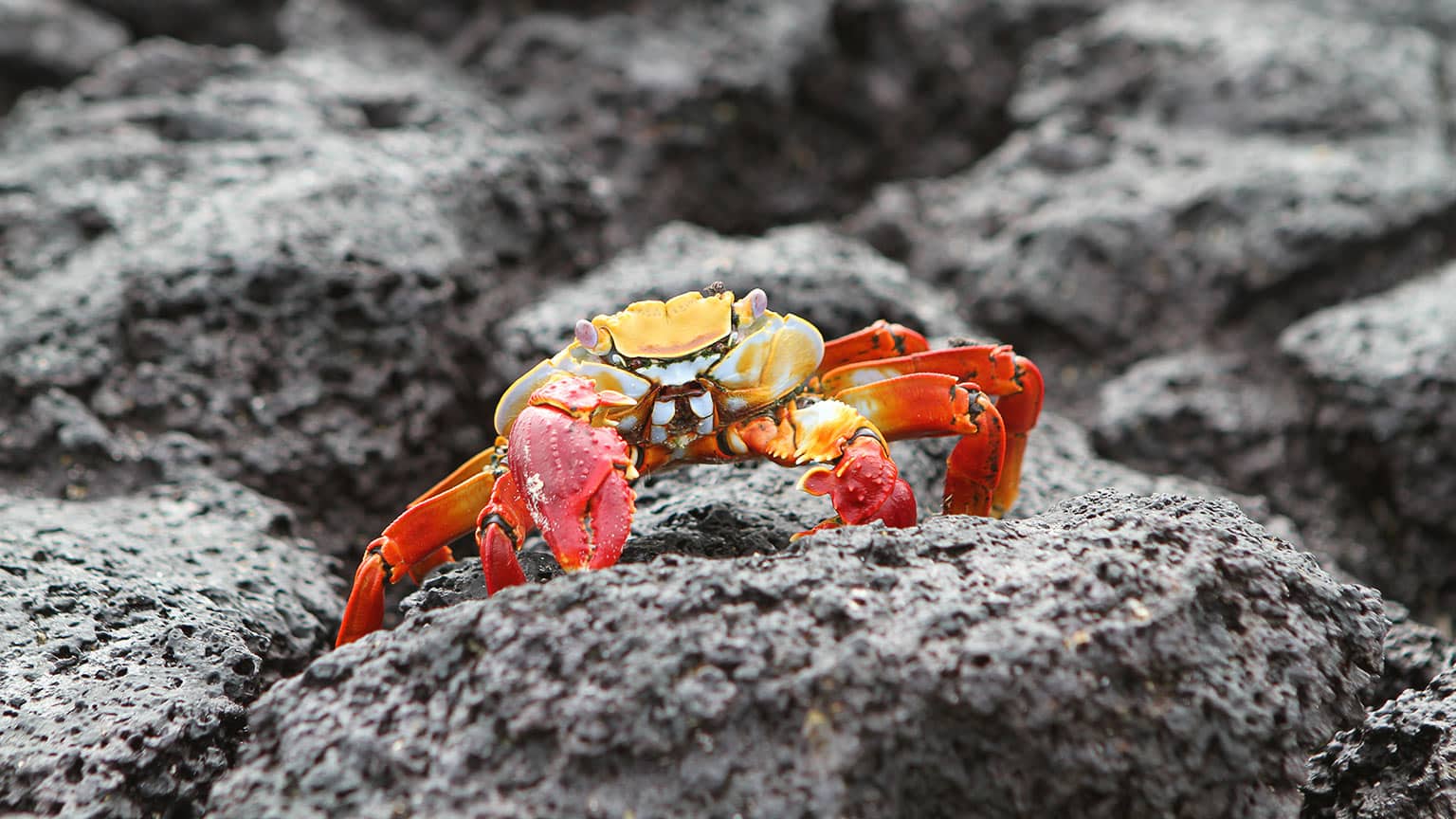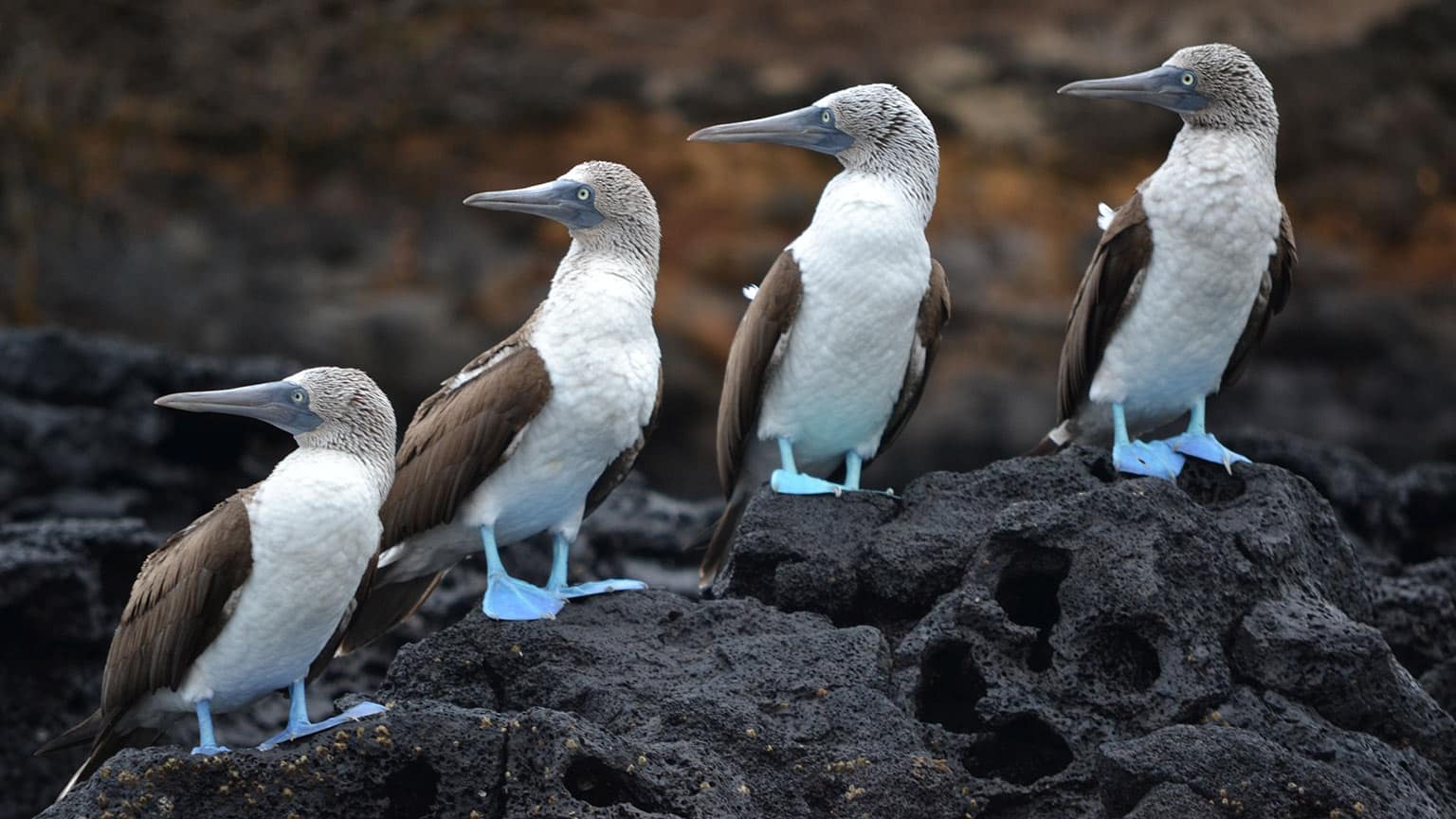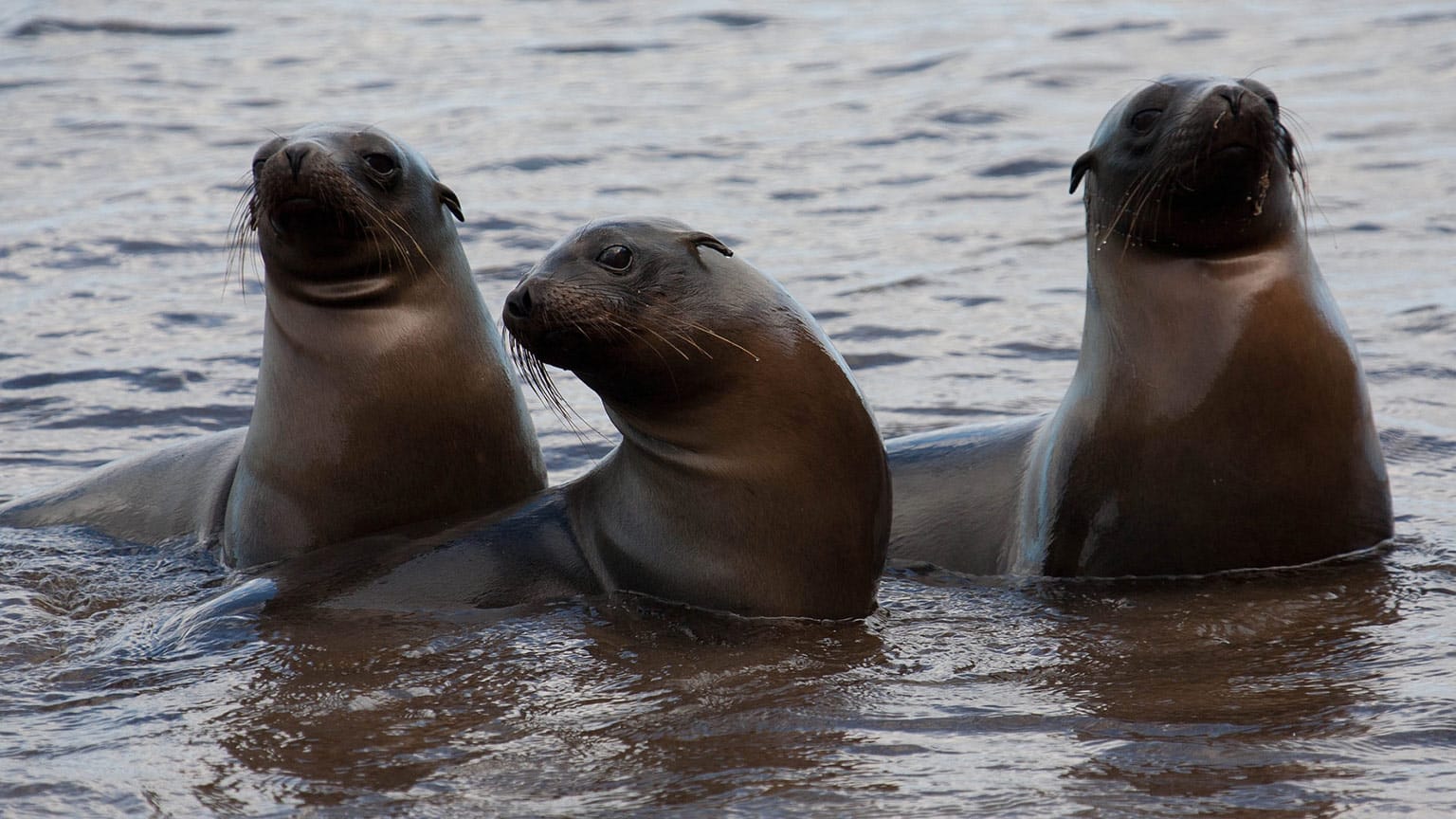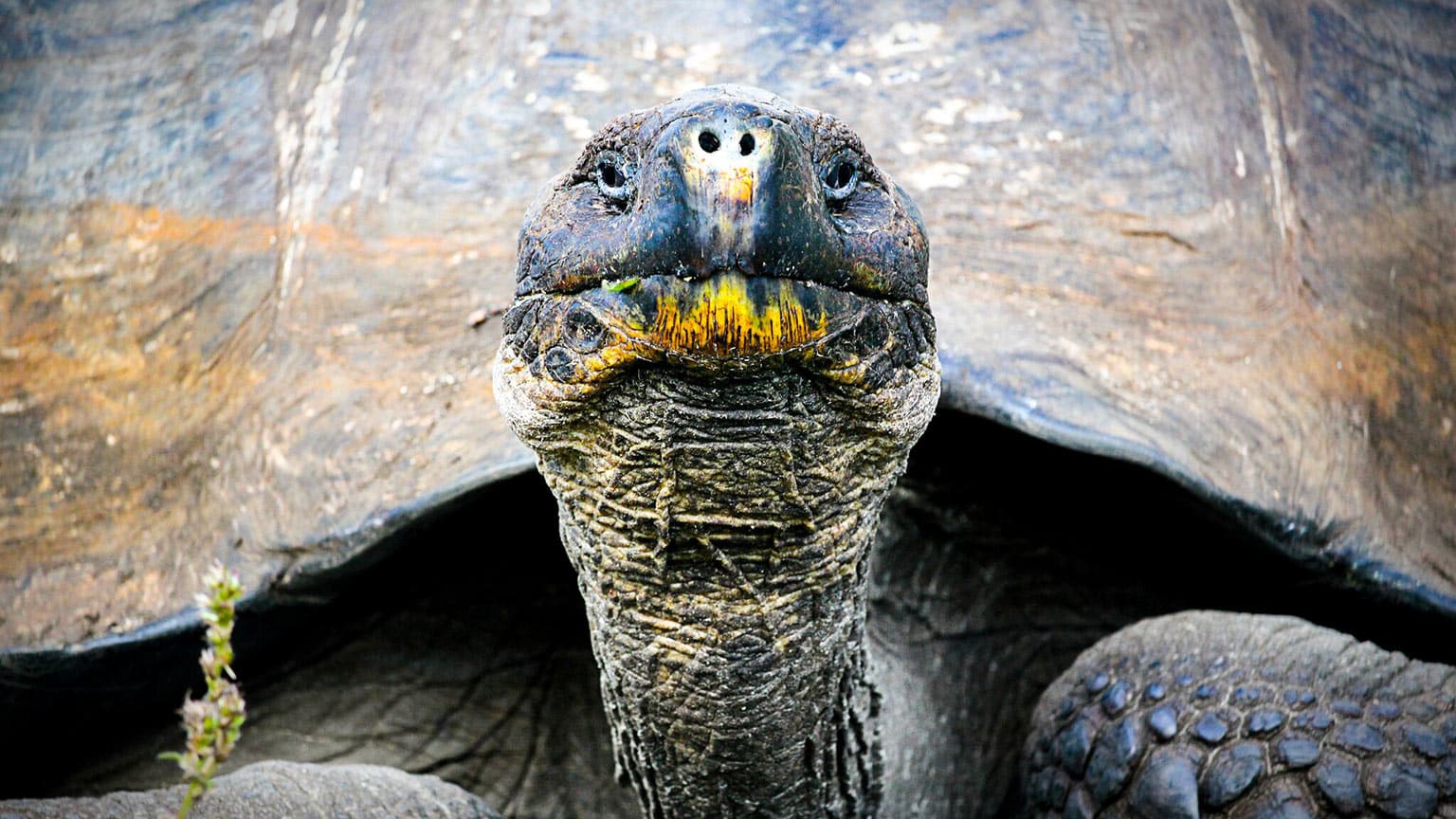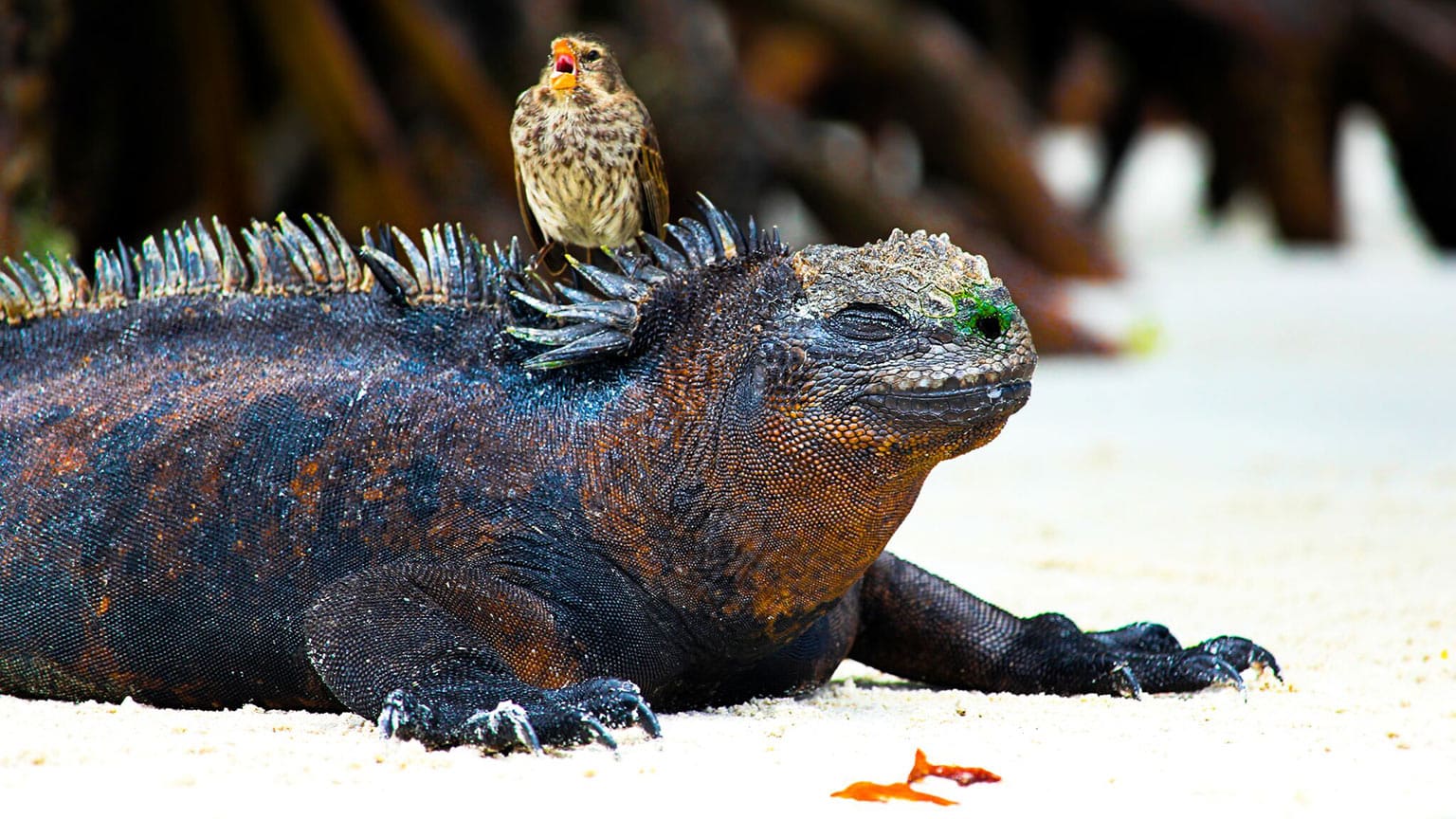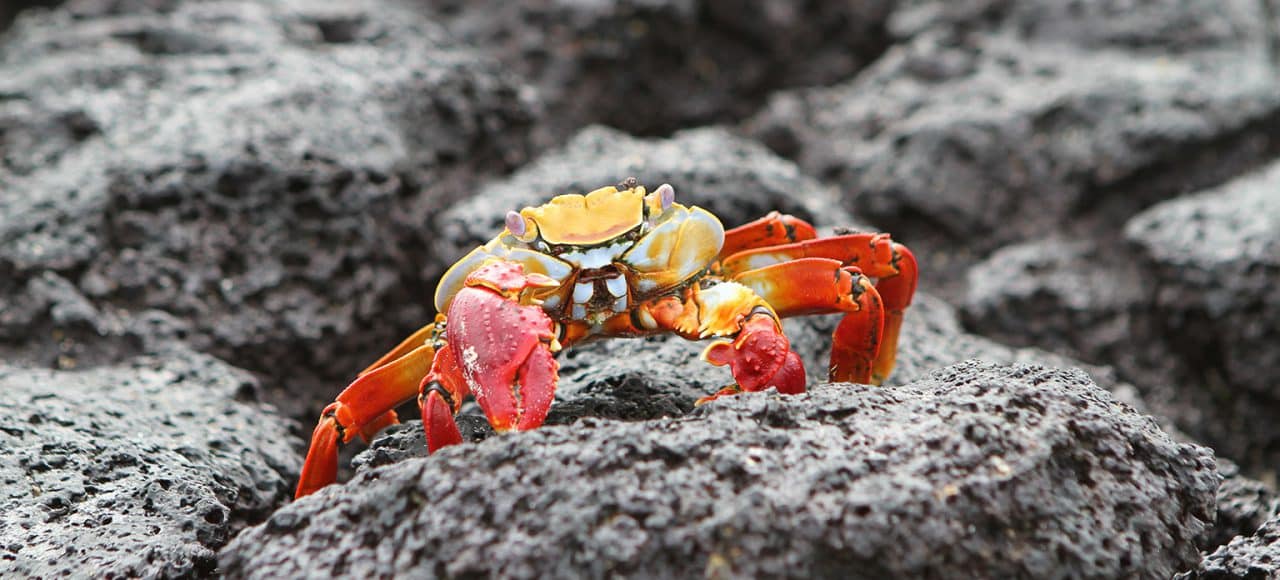Price
 $3039
$3039
We are also offering a June 9th departure of this program.
Overview
This 9-day adventure is perfect for those who want to experience the incredible wildlife and scenery of the Galápagos Islands but prefer to sleep on shore – so your time on the water is limited to commuting between islands. We'll take care of your flight bookings in and out of Quito — with the cheapest flight cost possible. That way you’ll be secure in knowing you've saved money, giving you plenty of time to explore the islands of Floreana, Isabela, and Santa Cruz as you spend your days with playful sea lions, giant manta rays, and the Galápagos giant tortoise. Visit the Galápagos with us, all while earning professional development credit with other educators.
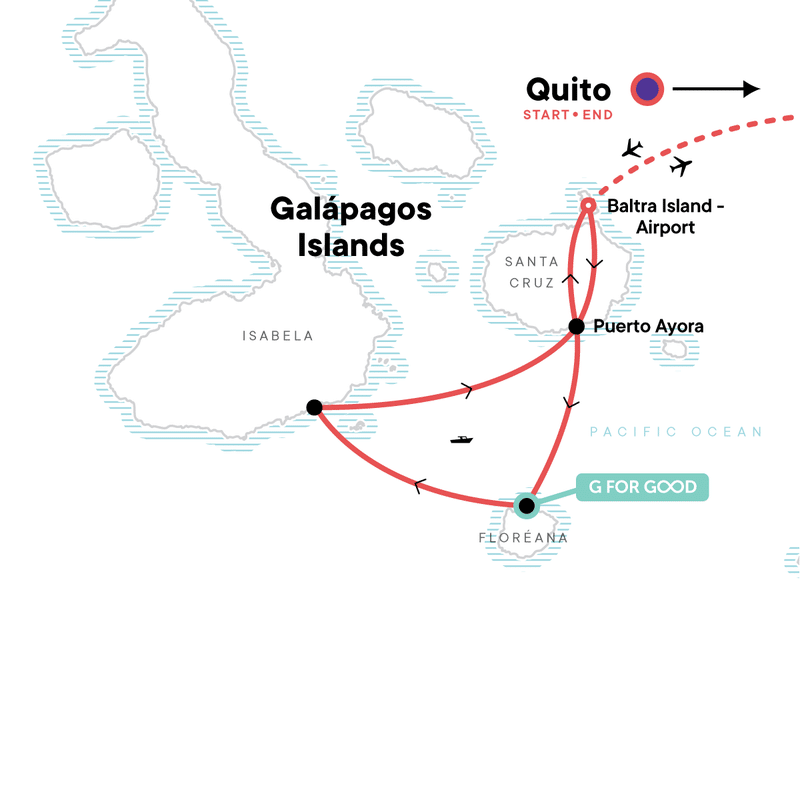
What's Included:
- Charles Darwin Research Center visit (Santa Cruz)
- Visit to Las Grietas
- Snorkeling at Loberia (Floreana Island)
- Flamingo Lagoon visit (Isabela Island)
- Sierra Negra volcano hike (Isabela Island)
- Giant Tortoise Breeding Center visit (Isabela Island)
- Isabela Municipal Tax
- Quito to Galápagos return flights
- Local Naturalist Guide while in the Galápagos Islands (certified by the Galápagos National Park)
- G Adventures representative in Quito
- 8 breakfasts, 1 lunch, 2 dinners – allow $185-$240 USD for meals not included
- All transport between destinations and to/from included activities by local flight, speed boat, van, pickup truck, local buses, panga boats
- Hotels (6 nts), G Adventures-supported community guesthouse (2 nts)
What's Not Included:
- International air travel
- Incidentals
- Travel health and cancellation insurance
- Applicable visas
- Tips or gratuities
- Airport taxes
- Beverages
- Meals not mentioned in itinerary
- Optional tours and admissions
- Airport transfers
Itinerary Download PDF
Arrive in Quito at any time. Due to the potential for flight delays or cancellations, we highly recommend that you plan to arrive in Quito at least a day in advance. If you expire flight issues and do not arrive before your group departs for the Galápagos Islands on Day 2, it can be very difficult and likely impossible for you to catch up with the group during the island hopping. We can book extra hotel nights for you in Quito before and/or after the trip, as well as optional day tours and excursions in and around Quito. Please note that check-in at the hotel is usually around 2:00-3:00 p.m. There are no planned activities until an intro meeting around 6:00 or 7:00 p.m., usually in the hotel lobby. Check for a sign or ask at the reception desk about the exact time and location of the group meeting. Please make every effort to arrive in time for this meeting. If you are delayed and will arrive late, please inform us. Your tour leader will then leave you a message at the front desk informing you of where and when to meet up tomorrow. After the meeting, you might choose to get dinner at a nearby restaurant with your traveling companions and your tour leader to further get to know one another. Located 2,850 m (9,348 ft) above sea level, the Ecuadorian capital of Quito enjoys a wonderful spring-like climate even though it is only a few miles south of the Equator. The old city is full of historic buildings and churches. We recommend spending an extra day or two in Quito. See our optional activities information below for a better idea of what there is to see and do.
We begin our trip with an early morning transfer to the airport in Quito and a flight to Santa Cruz Island, Galápagos, where we meet our friendly staff and check into the hotel in the town of Puerto Ayora. The Galápagos Islands are located about 1,000 km (620 miles) off the Pacific coast of South America. Covering nearly 5,000 square km (3,100 square miles), the Galapagos Islands are now a National Park. The archipelago is comprised of 13 major islands and scores of islets that served as a living laboratory for Charles Darwin, the renowned evolution theorist. We visit the Charles Darwin Research Station, a science organization initiated in 1964, which works to preserve the Galápagos’ ecosystem through the conservation efforts of scientists, researchers, and volunteers. It also provides a study location for international scientists and training for naturalist guides. Tour the exhibition center to see photo displays of recent volcanic eruptions, charts outlining geological formations, and drawings of the evolutionary development of endemic species. The station is also a great place to observe many species of tortoises and land iguanas in captivity, brought back from the brink of extinction. See the famous Galápagos tortoise up close – a corral houses adult tortoises, and a nursery cares for the young until around age 3 when their shells have hardened. Approximate travel time: 3 hrs by plane
In the morning of our first full day on the Islands, we walk through a cactus forest looking for Darwin finches and lava lizards on the way to Las Grietas, a local swimming hole, where the cool, bright turquoise water separates two volcanic cliffs. Fed by the ocean from one end and a river from the other, this unique, brackish pool is perfect for swimming. In the afternoon, we hop on a speedboat to nearby Floreana Island. The history of Floreana Island (also called "Charles") has gradually evolved to reach near mythic proportions. The story begins when a baroness and her two lovers, a German doctor and his mistress, and a German couple and their young son all came to settle on this land. Their dalliances and disasters, shrouded in mystery, were chronicled in John Treherne’s book The Galapagos Affair. Descendants of the German family, the Wittmers, still live on the island in the small community of Puerto Velasco Ibarra. Mrs. Margaret Wittmer has also written a book entitled Floreana, which can be purchased at the airport in Baltra or at a local bookstore. Floreana Island is a small, isolated island. Many of its residents have been living there for the past three generations since the islands were first colonized. Its 150 residents have tried to benefit from the tourism boom, but since most tourism is marine-based and the boats don't stop in the village, they have struggled to find any opportunities. Our partner tour operator G Adventures is investing in community training and infrastructure to develop the first ecological, community tourism program in the Galápagos Islands that sees both the island's small entrepreneurs and its unique wildlife as the primary beneficiaries of this project. To further benefit the community on Floreana Island, G Adventures has provided training to residents for all aspects of tourism, including food preparation and service. The community will provide your meals while staying on this small island. The meals are rotated between different community members in order to spread out the benefits of tourism. While eating at the community restaurants you will be contributing to the self-sufficiency of the first community tourism operator in the Galápagos. Approximate travel time: 2 hrs by speed boat Please note: Seas can be rough during this voyage, so please bring sea sickness medication to use as necessary.
Today, we start by walking along a black-sand beach to Loberia, where we enjoy snorkeling immediately off the beach and get up close to the diverse wildlife in the waters around the Galápagos. Please be aware: the water here can be rough and the currents strong, making swimming difficult (but not impossible!) for even the strongest swimmers. We then head up to the seldom-visited highlands of Floreana, where we will hear tales about the pirates, whalers, seal hunters, and buccaneers who once lived in this isolated and unique landscape. We will also learn about the birds, plants, and animals found on this small island.
After a tranquil night, we bid farewell to the mysterious Floreana Island and set off by speed boat to Isabela Island, where we check into our hotel. Shaped like a seahorse, Isabela is the largest island in the Galápagos archipelago and stretches over 100 km, though it is also extremely narrow. It is also a very active island, with six active volcanoes found on Isabella - Alcedo, Cerro Azul, Darwin, Ecuador, Sierra Negra, and Wolf. All of these volcanoes, except Ecuador, are still active, and two of them are over 1,700 meters high - Wolf and Cerro Azul. In the afternoon, we lace up our hiking boots in order to explore the Sierra Negra Volcano. As we reach the summit, we will circle the rim of the volcano, looking down into the largest basaltic caldera in the Galápagos. We will see smoking fumaroles and the "sulfur volcano" (large amounts of sulfur deposited around the fumaroles) along the way. This hike can be muddy and difficult, so if you aren't in good shape, ask your tour leader whether they think you should go on the hike. Approximate travel time: 2-2.5 hrs by speed boat Please note: Seas can be rough during this voyage, so please bring sea sickness medication to use as necessary.
This morning, you can spend free time as you wish, with the option (for $45-50 USD) to take a wildlife boat excursion to "Islote Tintoreras," a large crevice with clear, calm waters where marine iguanas swim and white-tip reef sharks (tintoreras) take their daily rest on the bottom. Spot pelicans, frigate birds, and diving blue-footed boobies, and keep an eye out for manta rays and rare Galápagos penguins, of which only 800 pairs of these lovable birds exist. You can even take the opportunity to snorkel to see Isabela's underwater world up close. Later, we walk through the town’s wetlands to visit the Giant Tortoise Breeding Center. We will pass basking iguanas and flamingos and head into the forest to see the gentle giants in their natural habitat. As the giant tortoise faced extinction, this program was established in the late 1950s to protect these noble creatures. You can further explore the surroundings with a short walk to observe pink flamingos in the wetlands and catch a stunning Isabela sunset on the beach. Along the way, stop at a lookout point, and visit natural pools, beaches, and mangrove swamps. In the evening, relax at the bar or on the beach and, if you want, enjoy a drink at sunset.
This morning, we travel by speedboat back to Puerto Ayora on Santa Cruz Island. Once there, we enjoy a walk along a lava stone pathway to the beautiful white beach of Tortuga Bay. You can relax on the beach, walk along the mangroves looking for marine iguanas and birdlife, or rent a kayak and explore this marine wonderland. Keep an eye out for Tintoreras sharks, sea turtles, and manta rays in the water's shallow areas. You will also have free time to explore Puerto Ayora. Head to the lively fish market where sea lions, pelicans, and other birds drop by to see the daily catch. You also have the option ($15 USD extra) to grab a life jacket and go for a kayak adventure in the mangroves of Tortuga Bay. If you choose to do so, you might catch a glimpse of some of the wide variety of marine life that calls the Islands home, including colorful reef fish, rays, and sea turtles. Relax afterward on the beautiful white sand beach and soak up some sun – you may even spot some iguanas also trying to catch some rays next to you on the shore. In the evening, you have free time to sample some of the local restaurants and bars or do a little last-minute shopping. Approximate travel time: 2-3 hrs by speed boat Please note: Seas can be rough during this voyage, so please bring sea sickness medication to use as necessary.
This morning, we take a private van to the ferry terminal on Santa Cruz Island, before taking a short ferry to Baltra. Upon arrival in Quito, transfer to the hotel for a final night in town. The G Adventures representative in Quito will be able to arrange many of the available day tours in and around Quito if you have time to spare. Approximate travel time: 3 hrs by plane
There are no planned activities today, so you may depart Quito at any time. If you wish to extend your stay in Quito, consider booking post-tour accommodation with us. Please note that check-out time from the hotel is usually mid-morning, but luggage storage services are available at the reception desk. Want more adventure? Book two or more GEEO programs in the same school year and receive a discount! GEEO will give you 10% off of the lesser value program(s) (up to 3 programs per year). If you would like to extend your time abroad but don't see another GEEO program that interests you, let us know. We can work with you to find a trip from our tour operator’s much larger catalog. Their tours are open to the general public and not designed specifically for educators, but we can still offer you and your travel companions a discounted educator price on any additional tours that you book.
Details
Frequently Asked Questions
Please read our general FAQs, where you can find essential information that applies to all of our programs.Resources to Learn & Teach about Ecuador and the Galápagos
Visit our recommended reading page to see the list of books GEEO recommends reading before your program (this is not required reading). We also have lesson plans and Pinterest boards that may be useful for you as you learn about your destination and prepare to bring lessons back to your classroom.Terms and Conditions
It is very important for you to visit our Terms and Conditions page before signing up for this program.GEEO Program Confirmation Process
We require a minimum of 6 participants for most GEEO programs. We officially confirm that a program will run once at least 8 people have signed up, which provides a margin for individual cancellations. Nearly all GEEO programs ultimately meet this enrollment quota, and in the rare event that a program does not meet the minimum requirement and GEEO cancels the program, we will work with you to find a suitable alternative or provide a refund of your deposit if you prefer. We encourage you to sign up for any program that interests you, and we will notify the entire group once 6 people are booked and again once 8 people are booked. We always emphasize the importance of exercising caution when making non-refundable travel arrangements, especially given the unpredictable nature of travel. For example, we typically recommend booking flights with flexible change/cancellation policies.Cancellation policy
All cancellations must be submitted to GEEO in written form by emailing your request for cancellation to travel@geeo.org. If you do not receive a confirmation that we have received your written cancellation request, please call us at 1-877-600-0105. Verbal cancellation requests will not be honored.- If you cancel 60 days or more prior to departure, all your program fee payments will be refunded besides your $350 deposit which is kept on file for future use
- If you cancel between 30 and 59 days prior to departure, you will receive a 50% refund and your deposit is kept on file for future use
- If you cancel within 30 days of departure, you will receive no refund, but your deposit is kept on file for future use
Trip Notes
- ITINERARY CHANGES: The itinerary is subject to further changes, dependent upon new regulations made by the Galápagos National Park or seasonal points of interest. The Galápagos National Park Service dictates the itinerary to G Adventures and GEEO, therefore the details of this itinerary could change a bit when you arrive. The content will be pretty much the same, but the order of the activities may change.
- GALÁPAGOS ISLAND PARK ENTRY FEE: The Ecuadorian government currently levies a Galápagos Islands Park entry fee of $100 USD per person. This is payable at the airport upon arrival in the park. It is not included in the cost of the tour and must be paid in CASH. This fee funds Park maintenance and supervision in Galápagos, as well as ecological study, conservation, and infrastructure development in Ecuador’s other National Parks. Entry fees, and the funds they generate for the National Park System, are among measures taken by the Ecuadorian government to protect its natural heritage.
- TRANSIT CONTROL CARDS AND TAX: The Consejo de Gobierno (local government council) has implemented a system of Transit Control Cards at a fee of $20 USD per person. This card is to be purchased in CASH at a counter in the Quito airport before boarding the flight to the Galápagos. Please retain this card along with your passport as you will be required to present this upon arrival to the Galápagos Islands. Please note that this applies to all tourists entering the Galápagos Islands and is a supplement to the existing entry fee to the National Park and is not controlled by tour operators or travel agencies. It is the first of a number of initiatives to track, control, and maintain the sustainable tourism targets set out by the Galápagos National Park and the Ecuadorian government in an attempt to preserve the fragile environment of the archipelago. There will also be a municipal tax of $5 USD per person charged locally upon departure from Isabela Island.
- SEA SICKNESS: The water is unpredictable (sometimes choppy, sometimes not), so definitely bring motion sickness pills for the boat rides between islands.
- INTERNATIONAL TICKET NUMBERS: Foreign travelers are exempt from paying a tax on domestic flights in Ecuador. To prove that you are indeed a foreign traveler, you must enter your international ticket number (ITN) into the Good To Go check-in system. Travelers who do not submit ITNs at least 30 days prior to Day 1 of their tour will be required to pay the domestic tax on all included flights.
- LUGGAGE: The maximum baggage allowance for domestic flights between Quito and the Galapagos Islands is one piece of luggage per person weighing a maximum of 23 kilograms (50 pounds), plus one carry-on piece weighing a maximum of 10 kilograms (22 pounds).
- ALTITUDE: Quito is at a high altitude and can be chilly in the evenings. Make sure you check the weather and have appropriate clothing. Also, you may have a headache and nausea when you arrive, which might be caused by mild altitude sickness. The best thing to do is to take it easy and try not to be too active. See a doctor in the rare circumstance that your symptoms are severe.
- SAFETY IN QUITO: Please take care when wandering about the city on your own, as pickpockets and purse-snatchers are common, particularly in the Old Town. Be safe and leave your passport, credit cards, and cash you don’t need in the hotel’s safety deposit box. Most Quiteños are honest and genuinely helpful and friendly, but be safe and enjoy the city!
Group Leader Description
All GEEO/G Adventures group trips are accompanied by one of G Adventure’s group leaders, which they refer to as Chief Experience Officers (CEOs). The aim of the group leader is to take the hassle out of your travels and to help you have the best trip possible. They will provide information on the places you are traveling through, offer suggestions for things to do and see, recommend great local eating venues, and introduce you to our local friends. Our itineraries often have plenty of free time to explore on your own. While not being guides in the traditional sense, you can expect them to have a broad general knowledge of the countries visited on the trip, including historical, cultural, religious, and social aspects. We also use local guides where we think more specific knowledge will add to the enjoyment of the places we are visiting – we think it’s the best of both worlds.Fitness Level
This trip includes light walking and hiking that is suitable for most fitness levels. Some of the optional excursions on this trip require participants to be in good shape, capable of hiking up to five hours. You are of course welcome to skip these optional excursions if you do not feel up for it. Those who choose to snorkel must be cautious that they can handle the water conditions, as some parts of the waters around the Galápagos have strong currents.Single Travelers
Half of GEEO’s participants travel by themselves, so please don’t worry if you do not have a travel companion for your trip. Our program fee is for one traveler in double-occupancy accommodation, and GEEO can find you a roommate of the same gender if you do not have a travel companion. Most of our programs have a “My Own Room” option, also known as a “Single Supplement,” which is an extra fee that you can pay to have a room to yourself. You will only incur an additional charge if you specifically request a single room. To see the price for the “My Own Room” option, please find your program on our extra services page. If you want to room alone, please email travel@geeo.org to request a single room.Joining Instructions
Day 1 is an arrival day, and no activities have been planned. Upon arrival to the city on Day 1, or earlier if you have booked pre-accommodation with us, please make your way to the joining hotel. Please note: Check-in time will be in the afternoon. A G Adventures representative will organize a short meeting soon after arrival, during which you will meet other tour participants and receive information about the trip. A welcome note will be left for you in the hotel so you have all the necessary information regarding the meeting time and your transfer times to the airport the next day. If you miss the Welcome Meeting, the G Adventures Representative will leave a note at reception for you with any information you may need and with instructions for the next morning. Excess luggage can be stored free of charge at the hotel in Quito during your tour, if necessary. The Quito International Airport is approximately 1 hour outside of the city center, where the hotel is located. There are a number of routes the driver may take depending on the time of day and traffic; the route often seems long and indirect. The easiest and cheapest way to get to the hotel is by organizing a taxi at the desk within the airport (approximately $30 USD). Private transfers generally cost more as the cars will need to drive from Quito to the airport and return to the city. Immediately after the customs and immigration area, as you head to the exits, you will find a taxi stand. We strongly recommend you pay for the car from the taxi stand, which uses a set rate, so that you don't have to worry about sorting out a ride outside the airport terminal, where the situation tends to get more chaotic with many drivers vying for few clients. The taxis outside the airport area do not belong to the Taxi Airport Union and may charge higher fares. There is also a shuttle available with the bus company Aeroservicios. Aeroservicios charges $8 USD for a bus ride that will take you from the new airport to the old airport. The buses are new, comfortable, and often include WiFi. From the old airport, a taxi to get to your hotel generally costs $5 USD, depending on the distance and location. If you pay in advance for an arrival transfer, a representative holding a G Adventures sign with your name will be waiting at the airport to meet you directly in front of the arrivals section. There are often many people holding signs, so we recommend taking some time to locate the representative holding a sign with the G Adventures logo and your name. If for any reason you are not met at the airport, you can go directly to the H.A.T.S. counter (Hotel and Airline Transportation Services), which is situated directly in front of the international arrival area, next to the taxi stand, and they will be able to assist you. In addition, you may call our local support line at 0999 506 000. If you are unable to make contact for whatever reason, please make your way to the hotel via taxi and report the issue to a G Adventures representative at the welcome meeting.Emergency Contacts
Should you need to contact G Adventures during a situation of dire need, it is best to first call their local G Adventures office. If for any reason you do not receive an immediate answer, please leave a detailed message and contact information so they may return your call and assist you as soon as possible. EMERGENCY CONTACT NUMBERS G Adventures Office - Lima, Peru During office hours (weekdays, 9am-6pm local time): +51 1 241 1650 After hours emergency number: +51 99 758 2712 (WhatsApp Available) If for any reason you are unable to reach the G Adventures local office, please call the numbers listed below to connect with their Sales team, who will happily assist you. Toll-free, North America only: 1 888 800 4100 Calls from UK: 0344 272 0000 Calls from Germany: 0800 365 1000 Calls from Australia: 1 300 796 618 Calls from New Zealand: 0800 333 307 Outside North America, Australia, New Zealand, Germany and the UK: +1 416 260 0999Packing List
Please read this article on GEEO’s blog for our staff’s suggestions on the best gear to pack for your upcoming travels. You must be prepared to carry your own bags and be comfortable carrying them up and down stairs, on and off transportation, and to hotels. As a rule, we try not to have to walk more than 15-20 minutes with your bags, which is why we recommend keeping the weight of your bags between 22-30 lb. Most travelers carry a backpack or rolling bag of small to medium size. No XXL bags please! A daypack is also essential for carrying everyday items. Space is limited on transportation, so there is a limit of one main piece of luggage per person plus a daypack per person. The maximum baggage allowance for domestic flights between Quito and the Galapagos Islands is one piece of luggage per person weighing a maximum of 23 kilograms (50 pounds), plus one carry-on item weighing a maximum of 10 kilograms (22 pounds). Additional bags or excess weight charges may apply. These charges are the responsibility of the traveler. Please note that Galápagos is a protected National Park, so your luggage will be checked before arrival and departure to and from the islands. Don’t bring any food, seeds, or other organic material that could affect the delicate ecosystem of the islands. That said, a participant in 2013 told us, “You can bring any processed food, even packaged nuts—this was very important for someone like me with dietary restrictions. I brought tons of protein bars, nuts, and granola!” Health & Safety- N95/KN95 face masks (at least a few just in case there is an outbreak within your group)
- Hand sanitizer
- Rapid Covid tests/antigen tests (at least 3)
- Windproof/waterproof rain jacket (very important)
- Personal clothing for cool to hot weather – we recommend packing 7 or 8 days of outfits so you only have to do laundry once
- Fleece top – it can fall into the 40s Fahrenheit!
- Light hiking boots or sturdy walking shoes
- Sport sandals or flip-flops
- Two bathing suits and a small quick-dry towel
- Daypack
- Sunblock
- Sunglasses
- Sun hat
- Water bottle
- Watch or alarm clock
- Toiletries – important: some hotels do not give you soap and shampoo
- Camera
- Motion sickness pills – Dramamine, bring both less-drowsy and regular formulas
- First-aid kit, including contain lip salve, aspirin, bandaids, anti-histamine, Imodium or similar tablets for mild cases of diarrhea, electrolyte powder, insect repellent, extra prescription drugs you may be taking
- Underwater camera or waterproof phone bag
- Snorkeling mask (there will be times where you can go snorkeling, but there might not always be a mask rental available)
- Wetsuit (the water can be chilly, and some have said in the past they wish they had brought their wetsuit)
- Rubber boots – optional: the hikes can be really muddy
- Binoculars
- Travel pillow
- Money belt
- Phone/tablet for internet – most hotels have WiFi
- Chargers for electronics as well converters/adapters, if needed
- AirTags or Tile trackers
- Packing cubes
- Earplugs
- Snacks – packing a few granola bars is a good idea; you can buy snacks when you get there too, so don’t go crazy
- Ziplock bags
- Reading/writing material
- Hand sanitizer/baby wipes
- Passport (with photocopies)
- Any entry visas or vaccination certificates required
- Travel insurance ID card
- Flight itinerary/boarding pass(es)
- USD/EUR cash
- Credit/debit card
- G Adventures vouchers
- GEEO Classroom action plans for your group – this is sent a few days before departure
Laundry
Laundry facilities are offered by some of our hotels for a charge. You can also use a local laundromat, if necessary. We recommend packing enough clothes so you don't have to do laundry.Passports and Visas
All GEEO trips require that the participant have a valid passport. Please see our general FAQ for information on obtaining a passport. As with all of our trips, we try to provide the most accurate information we can, but governments sometimes change visa rules. It is your responsibility to double-check the information we provide below by searching here. U.S. citizens do not require a visa to travel to Ecuador. Non-American participants should check online to determine if they need a visa.Money Exchange
The local currency in Ecuador is the U.S. dollar, so there is no need to exchange currencies. Make sure you bring plenty of cash to the islands—we recommend around $700-800—as ATMs can be hard to find or out of service, especially on Floreana. Small bills are better, so bring plenty of $5s and $1s. Credit cards are rarely accepted on the islands.Tipping
It is customary in Latin America to tip service providers such as waiters, at approximately 10%, depending on the service. Tipping is an expected, though not compulsory, component of this program and an expression of satisfaction with the people who assist you on your trip. Tipping is also one of the most direct ways that you can have a positive economic impact within the local community. Although it may not be customary to you, it is of considerable significance to the people who will take care of you during your travels. There will be opportunities during the trip to tip your local guides or drivers. You may do this individually, or your tour leader may offer to collect the money and give a tip on behalf of the group. Recommendations for tipping local guides and drivers range from $5-10 USD per person per day, depending on the quality and length of the service. Ask your tour leader for specific recommendations based on the circumstances and expectations. Also, at the end of your program, if you felt your G Adventures tour leader did an outstanding job, a tip would be appreciated. The amount is entirely your personal preference, but as a guideline, $5-10 USD per person per day would be appropriate.Vaccinations
GEEO cannot provide any medical advice, so it is very important to consult your doctor or a travel clinic about which vaccinations you will need for your trip. We recommend contacting Passport Health (http://www.passporthealthusa.com/), which has travel clinics located throughout the United States. You can also check the CDC's recommended vaccinations for your destination. Please take this seriously!Flights
We find the best prices for flights are often available around 90 days before departure, but of course this varies greatly from route to route and year to year. You should wait until this trip is confirmed before you book non-refundable flights. GEEO and G Adventures bear no responsibility for any flights purchased before the trip is confirmed. This program begins and ends in San Jose. Please double-check our itinerary for the date by which you must arrive in Quito. You may want to arrive in Quito one or more days early in case you have flight disruptions. You can arrive at any time you choose, but try to make it in time for our 6:00 p.m. Welcome Meeting on Day 1. You can depart from Quito any time on the final day of the program, or stay later to see more of the city.Plugs and Converters
Ecuador uses the same plug design and voltage found in the United States—a type-A plug and 120 Volts—so there is no need for electrical adapters or converters.Expectations
Before you decide to travel with GEEO, it is important that you read all of the information about the program you are considering. Remember, our programs are quite adventurous.- The purpose of the accommodation is to provide a safe, well-located place for you to sleep. Sometimes you will be pleasantly surprised, but do not expect luxury as we are trying to keep these trips as inexpensive as possible. Sometimes the accommodation is not air-conditioned.
- We use a mix of transportation that gets our guests from location to location safely. Sometimes you will have full days and nights of transportation as our trips tend to cover a lot of ground. The transportation will often be an adventure in itself.
- You must be able to easily carry or roll your luggage, so do not over-pack.
- Many of our programs occur in locations where it is very hot during the day. Please make sure you have thoroughly read the itinerary and can handle the group activities, which sometimes include day hikes with your daypacks.
- We recommend always carrying snacks with you. Meals can sometimes be far apart.
- Please make sure you understand the role of your tour leader on this trip as they are not the traditional “guide” you may be expecting. While our trips are educational, they aren’t study/lecture trips. We want you to learn through exploring, and much of your experience will be based on how active you choose to be in acquiring knowledge and interacting with locals.


